Nepalese cuisine is renowned in Nepal and neighboring countries. Explore the top foods loved by locals. While Nepal doesn’t have a distinct cooking style, regional meal habits vary. The influence of Indian and Tibetan cooking is evident, with authentic flavors seen in Newari and Thakai cuisines.
Nepal’s stunning natural beauty earns it the reputation of a heavenly destination, attracting tourists worldwide. The country, rich in multicultural influences from neighboring nations, boasts a diverse culinary scene. If you’re planning a trip to Nepal and curious about the local favorites, discover the top ten foods cherished by Nepalese for a taste of authentic flavors.
Nepal is a country rich in cultural and culinary traditions. Its diverse geography, from the high Himalayas to the fertile plains, has given rise to a vibrant food culture that reflects the nation’s history and ethnic diversity.
As a travel destination, Nepal entices visitors not only with its natural beauty but also its tantalizing cuisine. While trekking through mountain trails, one can sample simple yet hearty dishes made from locally sourced ingredients. In the cities and towns, restaurants serve delicacies passed down through generations alongside adaptations of global favorites.
In this article, we explore 10 of the most famous and beloved Nepalese foods that every visitor must try.
Table of Contents
Dal Bhat Tarkari
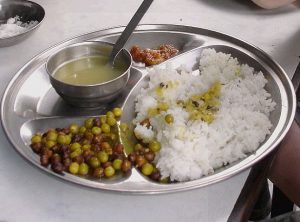
Nepal’s staple and beloved dish is Dal Bhat Tarkari, a must in Nepalese life. Bhat, steamed rice, pairs with Dal (lentil soup) and Tarkari (curry). Achar (pickle) and yogurt complete the meal. Rice, a daily essential, is enjoyed for breakfast, lunch, or dinner.
Nepalese culture embraces this dish, a flavorful combination of rice, soupy dal, curry (vegetarian or non-vegetarian), achar, veggies, and salads. A daily delight, it’s not just a restaurant specialty but a must-have at home or any occasion, ingrained in Nepalese culinary tradition.
No list of iconic Nepali dishes is complete without Dal Bhat. This combination of lentil soup and steamed rice constitutes the foundation of most meals across Nepal.
Dal Bhat’s ubiquity and affordability have earned it an important place in Nepalese food culture. Locals commonly use the phrase “Dal Bhat power, 24 hour” to highlight its nourishing qualities that provide sustained energy.
Its basic ingredients belie the variety of ways that Nepalis prepare Dal Bhat. The soup features lentils like red masoor or black urad cooked with tomatoes, garlic, cumin, and other spices. Bhat refers simply to boiled rice, which can range from white to brown or red varieties. Side dishes like spicy achars (pickles), roasted meat and vegetables, curd, and greens often accompany this nutritious duo.
Nepali Khana Alu Jira cooking method
Time will take 20-25 minutes. 3-4 people can be satisfied with these snacks.
Ingredients Alu Jira
These are the ingredients items needed to prepare Alu Jira healthy Nepali khana recipe.
Items Quantity
- Boiled potatoes 500 gm
- Jeera seeds ½ tsp
- Butler 1 tsp
- Salt To taste
- Chili powder As required
- Turmeric powder, As required
- Zeera powder ½ tsp
- Garam masala ½ tsp
- Ginger, garlic (paste) 1 tsp
- Onion (chopped) 60 gm
- Tomatoes 60 gm
- Green chilly 2-3 pieces
- Coriander (chopped) 2 tsp
Alu Jira preparing method
- Cut boiled potatoes into long jardiniere shapes.
- Chop onion and tomatoes—heat butter in a pan.
- Add jeera seeds to the hot butter and fry it.
- After it turns black, the onion is chopped and fried.
- After the onion turns golden brown color, fry the cut potato.
- After turmeric powder and jeera powder, garam masala, ginger, garlic paste, and chili powder, stir it.
- After 3-4 minutes, add tomatoes, fresh green coriander leaves, and salt.
- Add a small amount of water if necessary.
Momo
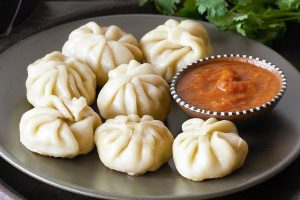
When one thinks of Nepalese food, steamed momos likely come to mind first. Filled dumplings constitute a popular snack across the Himalayan region, and Nepal offers its own take stuffed with seasoned meat or vegetables.
Momos originated among Tibetan communities in the mountains of Nepal. Historically, Tibetan traders traveling south into Nepal and India would carry these dumplings as provisions. Their popularity then spread to other communities, like the Sherpas in high-altitude villages.
In Nepal today, one can find momos sold everywhere from hole-in-the-wall street stalls to high-end restaurants. The half-moon-shaped dumplings come steamed or fried, accompanied by a fiery chili sauce. Fillings range from traditional minced buffalo meat to modern vegetarian options like paneer cheese and cabbage.
Momo, a ubiquitous dish in Nepal, is widely available and a culinary favorite. Found on nearly every menu, hotel, and restaurant, Momo comes in various types—veg, buff, chicken, mutton, and more. Regardless of the region, Momo is cherished nationwide.
These dumplings, with diverse sizes, colors, and fillings (buff, pork, chicken, vegetables, paneer, and even chocolate), are not only affordable but incredibly delicious. The wheat and flour skin adds a delightful texture. Served with achar (chili sauce), the versatility of Momo extends to preparation methods—fried, steamed, Kothey (half-fried, half-steamed), chilly, and more. A true Nepali delight enjoyed by all.
Thakali Khana Set
The Thakali people indigenous to the Annapurna region have contributed an iconic cuisine to Nepal’s culinary repertoire. The Thakali Khana Set showcases their distinct ingredients and cooking techniques.
This elaborate meal comprises over a dozen dishes arranged on a metal tray. It represents the diversity of the Thakali landscape, with items like Bhedako Masu (goat meat), Bandhelko Masu (dried meat), sweet and sour Ghundruk greens, black lentil soup, apple pickles, and more. Steamed red rice sits at the center.
Food plays an integral role in Thakali culture. Their cuisine evolved to provide nourishment for traders traveling through the mountains. The traditional Khana Set embodies this hearty, balanced fare that sustained the Thakali people for generations.
Aalu Tama
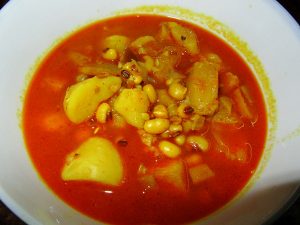
Aalu Tama, a traditional delight, is a cherished dish in the hilly regions of Nepal. A delightful blend of potatoes and bamboo shoots (Tama), enhanced further with the addition of black-eyed beans. This traditional preparation is a unique combination of fermented bamboo shoots, potatoes, and black-eyed peas. The result is a slightly sour yet richly flavored dish with a refreshing taste, showcasing the distinct culinary traditions of the hilly regions in Nepal.
Yomari
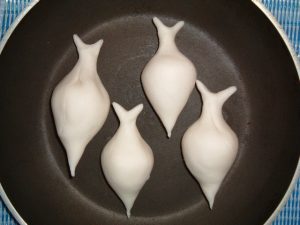
Yomari, a cherished dish among Newars in the Kathmandu Valley, is a delightful treat. This unique delicacy involves filling dumplings with rice flour shaped like figs, and then adding a mixture of molasses and sesame seeds. The final touch is steaming it in a pot known as potasi, resulting in a delectable combination of flavors and textures.
This sweet delicacy holds special significance in Nepali culture as a treat associated with the post-harvest festival of Yomari Punhi. It also highlights the enduring influence of the Newari people, Nepal’s original inhabitants in the Kathmandu Valley.
Chatamari
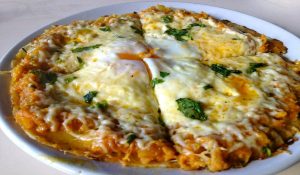
Chatamari, often hailed as the ‘Nepali Pizza,’ is a beloved Newari dish and a favorite among Nepalese. This rice flour pancake offers a delightful canvas for various toppings, including eggs, meat, or vegetables, tailored to the customer’s preference. A staple during Nepali Newari festivals like Dewali and Degudeopuja, Chatamari is typically served with chicken curry or soup. Affordable and readily available, this dish is a must-have on any occasion within Newari culture, found in local cuisines, restaurants, and even street vendors.
Sel Roti

No celebration in Nepal is complete without this iconic fried bread. Sel rotis are sweet, crispy rings made from rice flour that resemble doughnut holes. Nepalis enjoy them during holidays like Tihar, Dashain, and Teej.
The name comes from the Nepali words for dough (sel) and bread (roti). Their precise origin remains unknown, but some historians link them to similar South Asian fare or Tibetan khaja treats.
Locals line up to take bags of sel rotis home to share with family and neighbors, sweetening their celebrations.
This ancient dish is crafted from semi-liquid rice flour infused with cardamom, cinnamon, butter, and cream for a rich taste. The mixture is then skillfully shaped into rings and deep-fried in high-temperature oil until golden brown on both sides. Traditionally prepared during Tihar, Sel Roti features rice flour mixed with salt and sugar, creating a liquid batter poured into hot oil to form a circular shape. Enjoyed with curry or commonly paired with tea or coffee, Sel Roti is a flavorful and festive treat.
Kheer
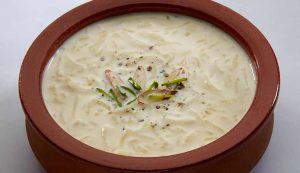
Who else is there in Nepal who doesn’t love Kheer? It is one of the sweet dishes that is prepared by adding rice, fruits, cinnamon powder, and cardamom powder to the boiling milk. Once it is cooked, it is ready to eat.
Gundruk
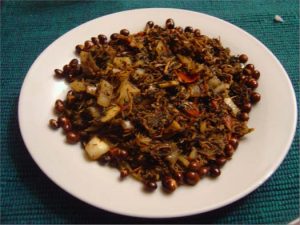
Gundruk is a dried and fermented vegetable prepared in most parts of Nepal. It is very simple and fast to make this dish. Nowadays, people are using it to prepare for the pickle called Gundruk ko Achar.
This staple of Nepali cuisine originated as a method to preserve leafy greens through fermentation during winter months when fresh vegetables remained scarce. The sour, tangy pickled leaves still retain their importance, accompanying meals or eaten as a snack.
Gundruk utilizes local plants like mustard greens, radish leaves, cauliflower greens, or soybeans. After harvesting, they get compressed and fermented, then dried into cakes. Cooked with spices, Gundruk makes a nutritious side dish or stuffing for snacks.
Beyond cuisine, Gundruk also carries cultural value for Nepalis as an emblem of traditional food preservation techniques. The flavors evoke nostalgia and connections to village life.
Samayebaji
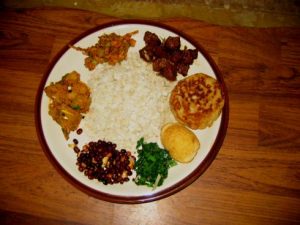
Samayebaji, a popular Newari dish, has found its place in the Nepalese market. This traditional recipe is a rich assortment of flavors, featuring beaten rice, black soya beans, smoked meat, potato, roasted meat, boiled and spicy beans, boiled eggs, ginger, pickle, green vegetables, and Mewari liquor. The Newar culinary heritage also boasts meat-centric dishes such as Chhoila, Kachila, Sekuwa, and Momo, along with special bread like Chatamari and Bara. Additionally, they produce homemade drinks like Chhyang, reflecting the diverse and flavorful offerings of Newari cuisine.
This celebratory meal carries cultural meaning related to communal dining and hospitality. Historically, Newari families would host Samay Bajis to honor guests and special occasions. The tradition continues today at festivals and life cycle rituals.
Gundruk and Dhendo
Dhendo, a porridge made of cornmeal, can also be made with millet, buckwheat, or barley. A fermented and preserved leafy green called Gundruk is used to make soup or pickles. They combine to provide a satisfying, healthy dinner. The addition of meat curry to the pair in the urban environment further enhances the overall appeal of the dish. Basically, served Nepal’s rural communities in the high terrain.
There is a special food Nepalese love to add to their identity. It is called Makai and Bhatmas (Fried maize and beans), and it tastes amazing being accompanied by Gundruk ko achar (Pickled dehydrated vegetable leaves).
Conclusion
Nepali cuisine offers remarkable diversity that reflects the country’s ethnic plurality and geographical range. Staples like Dal Bhat meet localized specialties tied to festivals, rituals, and regional ecologies. Whether trekking through high mountain passes or strolling bustling bazaar lanes, visitors can discover an authentic taste of Nepal in every spoonful.
There are mouth-watering dishes that you can prepare at home and enjoy. But Nepali cuisine is very underrated in my view. We have a variety of mouth-watering dishes ranging from sweet to spicy. And believe me, with the right technique and spices, these food items will give you the ultimate happiness. Here is the list of other popular foods in Nepal specially dedicated to all the foodies out there.
- Chowmein: Chowmein, a popular noodle dish in Nepal, offers a variety of meat, spices, and vegetables. Affordable and available everywhere, each place adds its unique twist, making it a beloved choice among Nepali people, often rivaling the popularity of Momo.
- Saifale: Similar to Momo, Saifale presents a delightful twist with its fried, thick-skinned exterior adorned with an intriguing design. Customizable fillings, affordability, and widespread availability make it a highly praised and tasty treat, often served with diverse achar options.
- Chapati Curry: Chapati, a wholesome flatbread made from wholemeal flour, pairs perfectly with curries, vegetables, daal, and achar. Found in most Nepali households, this affordable and hearty option is a daily staple and widely available across the country.
- Thukpa: Ideal for winter, Thukpa is a noodle dish with a thick soup, popular in the Himalayan region of Nepal. Ordered frequently, it features a delightful mix of vegetables, Himalayan spices, and a choice of meat or a vegetarian option. Tibetan restaurants in Nepal offer a diverse range of Thukpas.
- Newari Khaja Set: A traditional cultural dish for the Newar community, the Khaja Set is a must on special occasions and a daily favorite. Featuring baji, Bhutan, Choila, roasted and smoked meat, spiced beans, egg, fish, potatoes, and vegetables, this set showcases the rich flavors of Newari cuisine. Accompanied by the special drink Chyang or Aila, a home-brewed rice liquor, it represents the essence of Newari culinary traditions.
- Laphing: Laphing is a food of Tibetan origin. It is better considered a snack than a full meal. It is a spicy food item that has the most amazing flavors. Laphing is very popular in Nepal and if you want to experience the best of it make sure to visit Bouddha. You will find a wide variety of it and the best thing is that Laphing is very easy in your pocket as well. It is a street food easily available in Nepal, especially in Kathmandu and Pokhara. It is something like noodles served with red pepper chili, cilantro, green onion sauce, and soya sauce. These flavors combined give you the perfect snack to munch on.
- Makai Vatmas: Makai Vatmas is all time favorite Nepali Khaja .It is quite popular, especially in remote areas of Nepal. The best thing about Makai Vatmas is that it is very healthy and gives you the just required protein. It is fried corn and soybean seeds mixed. It is often consumed with Sadheko Gundruk and mula ko achar. It is easy to prepare and you can even store it for later use. That’s one of the reasons why it is very popular. Makai Vatmas has been eaten for a very long time. In past days when people had to do hard work that required a lot of stamina, Makai Vatmas used to fulfill that need. Still, now it is preferred by many and thus Makai Vatmas makes up to this list.
- Chhoila: Chhoila is the specialty of the Newari people of Nepal. It is no doubt one of the best Nepali dishes. Chhoila is simply buffalo meat prepared with a special process. First, we cook the meat and then mix it with different spices. That makes it full of flavor. The cooking process is also quite different which gives it a smoky flavor. Once cooked, we mix it with lemon, ginger, garlic, coriander, green onion, spices and then serve. It is more than just a flavored buffalo meat, the technique followed in the process makes it very special and unique. Chhoila is a dish you must try at least once in your life. And believe if you try once, you will end up wanting more.
These were some of my favorite dishes. Don’t forget to tell us your favorite dish in the comment section. Is there something I am missing out? Every mom has their specialty, Which is the dish that your mom makes which makes your taste buds go crazy? Don’t forget to mention this in the comment section below.
